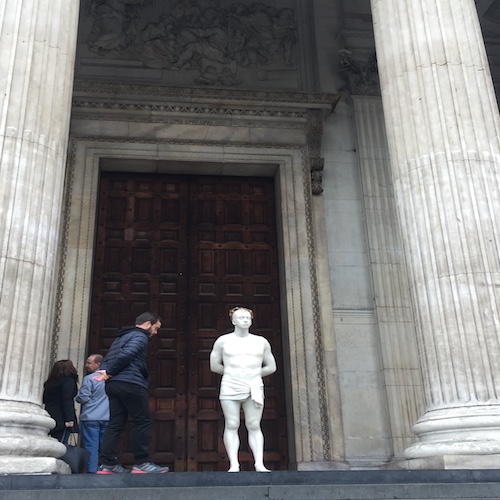
In 1999, renowned British artist Mark Wallinger’s statue ‘Ecce Homo’ was installed as the first work of art on Trafalgar Square’s fourth plinth. The life-sized statue of Jesus Christ, wearing nothing but a small cloth and a barbed-wire crown, is made of white marble rein. Some find ‘Ecce Homo’ to be humble in comparison to the statues that surround it in Trafalgar Square. While Trafalgar Square is filled with grand artwork including large statues of seemingly important men in power-stances or on horses, as well as robust statues of lions, ‘Ecce Homo’ represents simplicity and vulnerability, with its eyes closed and hands bound behind its back. Richard Dorment, the chief art critic for the Daily Telegraph between 1986 and 2015, is quoted as saying: “What Wallinger has done is to turn Trafalgar Square into something akin to a vanitas, a mediation on the transience of earthly things, making all other statues in this square look hopelessly pompous” (“Trafalgar Square’s”).

At the moment, though, ‘Ecce Homo’ does not stand in its usual place on Trafalgar Square’s fourth plinth. It currently sits on the steps outside of St. Paul’s Cathedral. At St. Paul’s Cathedral, I noticed a sign advertising the collaboration between St. Paul’s Cathedral, Mark Wallinger, and Amnesty International before I noticed the statue itself. I found it refreshing to see an intersection between a major religious cite, a contemporary artist, and a human rights organization. But the fact that Amnesty International was involved in this partnership particularly peaked my interest because I researched Amnesty International and similar human rights organizations last term when I participated in a simulation in my American Foreign Policy class at Carleton, where I “played” the director of a human rights NGO. I was surprised but excited to find manifestations of material I’d studied last term at Carleton in London.

Amnesty International works like most human rights NGOs, campaigning for global human rights by lobbying governments and companies. Amnesty International is the world’s largest human rights organization, with over 7 million people throughout the world involved in it. By partnering with St. Paul’s Cathedral and Mark Wallinger, Amnesty International, according to the promotional poster that first caught my attention, is aiming to “highlight the plight of those who face torture or execution, or imprisonment for their political, religious or other beliefs.”

If you are interested, you can find out more about the work of Amnesty International on their website: https://www.amnesty.org.uk. I looked into Amnesty International’s recent anti-torture campaigns in the UK and found that Amnesty International has been researching the UK’s involvement in the global anti-terrorism program launched by the US government and its allies (such as the UK) after the attacks of September 11 (“What was the UK’s”). I also found that during the London Arms Fair in 2015, where, according to Amnesty International, guns, tanks, killer drones, and illegal torture equipment was being advertised and showcased to governments (including “known human rights abusers”), Amnesty International launched a campaign and distributed an ironic advertisement that read: “London Arms Fair 2015. Featuring Guns, Tanks, Killer Drones. You may also find offers of Illegal Torture Equipment” in order to raise awareness of these distributions of illegal weapons (“The London”).

‘Ecce Homo,’ one (of many) of Amnesty International’s anti-torture campaigns in the UK will be on display outside of St. Paul’s Cathedral until May 22.
— Meredith Bergman ’19
Works Cited:
“The London Arms Fair 2015: The Ad Campaign The Government Never Wanted.” Amnesty International.
“Trafalgar Square’s Fourth Plinth.” The Telegraph.
“What was the UK’s Role in CIA torture?” Amnesty International.
